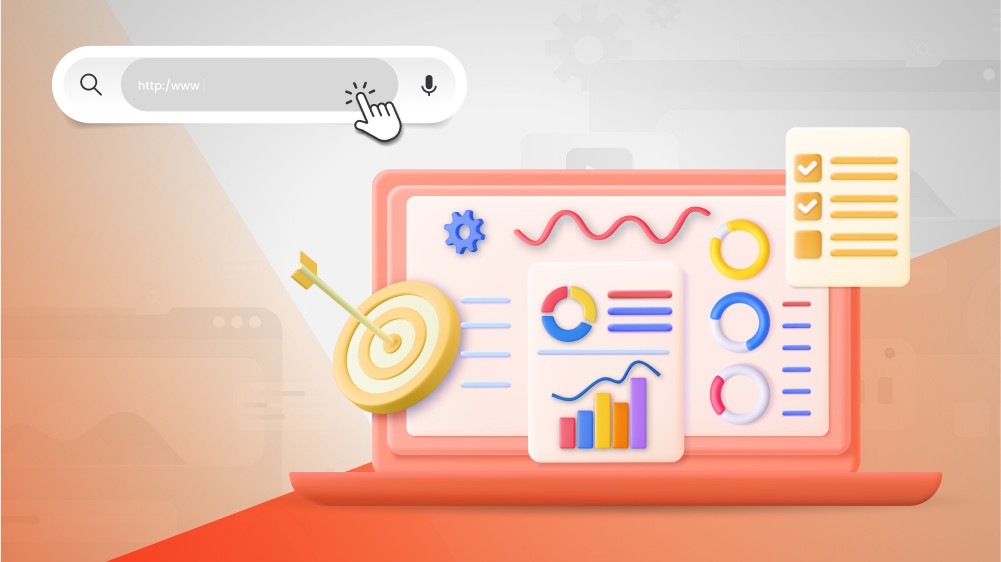
Unlock the Power of Web Apps: The Best Platform for Web Application Development

Content Map
More chaptersInternet users today have gotten used to the seamless online experience. This means users are more engaged when a website is user-friendly, interactive, and not simply static. Worldwide internet usage reached 5.19 billion people as of July 2023, or 64.6% of the world’s population.
This expectation has placed more pressure on businesses and developers to deliver high-quality applications, especially web applications. It is understandably difficult to navigate when there are approximately 1.5 billion websites on the World Wide Web today, and new web development tools are introduced constantly.
This article will provide you with all the information that you need to know about platforms for web application development and hopefully guide you toward the start of your own web app journey.
Web Application: All You Need To Know

Definition
Essentially, a website application or web app is an application software that is provided via the internet using a browser interface, and it is kept on a remote server. By definition, web services are web apps, and most websites—though not all—contain web apps. It relies on an internet connection.
You can launch a web app on a computer, mobile browser, smartphone, or on a mobile device like a tablet. Most web apps are responsive and adapt to the mobile device’s interface.
Examples of commonly used web apps are Netflix, Google Docs, Trello, Gmail, and Facebook; online calculators and online stores are also instances of web apps.
Web apps and websites are different. The biggest difference between the two terms is that websites are static, and web apps are dynamic. Websites consist of both textual and visual content that can be read and viewed, while web applications enable users to interact with a website.
Types of Web Apps
There are seven types of web apps:
Static Web App
Static web apps are the simplest form of web apps, built using HTML, CSS, and JavaScript code. Examples of static web apps are informational or read-only sites like brochure websites and portfolio and resume websites.
Dynamic Web Apps
These are more complex. Dynamic web apps deliver data in real-time and even present different kinds of data to users. Examples of dynamic web applications are YouTube and Facebook.
E-commerce Web App
E-commerce web apps are like an online store. They provide users with all sorts of functions, including payment management, adding new products, removing old ones, etc. Nike and Amazon are e-commerce web apps.
Single-page Web App
Viewed as a modern way of creating dynamic web apps, single-page web apps require little data. Therefore, they are fast and responsive. Gmail is a single-page web app.
Progressive Web Apps
Or PWA for short, are like mobile apps, which means you can install them. They are launched via a web browser of a device and are not dependent on an internet connection. Instances of PWAs are Pinterest or Starbucks.
Portal Web Apps
The idea of portal web apps is for users to browse through different contents without leaving the site, as the user is provided access to many pages and links. Examples are Coursera and Udemy.
Business Web App
These web applications are tailored to the specific requirements of businesses and organizations and may include applications such as CRM and ERP systems.
Why Are Web Apps Crucial for Your Business?

By now, you have probably recognized many familiar web app names, and you might even be using them in your daily life. This goes to say that web apps are extremely popular due to being accessible anywhere and everywhere. It has also gained popularity due to a few reasons.
- They are easy to maintain and update, with no need for hard drive capacity.
- You do not need permission from various app stores since they are accessible from web browsers.
- They are easily customized.
- Web apps streamline business operations since your data is centered in one place.
As long as you have a clear view and goal in mind of what features and functions you are looking for, the right web app platforms and dedicated team of web developers will help you turn your dream application into reality.
What Are Web App Development Platforms?

Web App Development Platforms are software platforms that allow users and developers to create web applications. They offer development environments, drag-and-drop capabilities, and no-code or low-code tools to enable the development of web applications that are progressive and responsive.
There are five types of app development platforms: native app development platforms, cross-platform app development platforms, web-based app development, and server-side app development platforms.
Top 8 Platforms for Web Application Development
With so many web development programs on the market, it can be difficult to know which one to use and in which cases it is best to use a particular programming language. Worry not, as we have compiled a list of the eight best web development tools.
Ruby on Rails
- Developer(s): David Heinemeier Hansson
- Type of Platform: Linux, Cross-platform
- Applications built using the platform: Airbnb, SoundCloud, Square, Shopify, Zendesk, GitHub
Ruby on Rails (Rails), or simply Rails, is an open-source web application framework designed to facilitate the development of fully-fledged web applications. It is built on top of the popular Ruby programming language, making it a popular choice for web development.
As a full-stack framework, Ruby on Rails comes with many pre-built features and offers good developer experiences. These features, like the ability to connect to a database, use a templating engine, and handle routing, enable developers to launch web applications faster than other web frameworks. Many have considered this web developer tool to make the process fun and easier.
When to choose this platform:
- Creating e-commerce sites
- Building stock marketing platforms
- Social networking platforms
- Custom database management systems
Django
- Developer(s): Django Software Foundation
- Type of Platform: Cross-Platform
- Applications built using the platform: YouTube, Instagram, Pinterest, Spotify, and Dropbox
Django web framework is a Python-based, high-level framework for building secure, maintainable, and fast websites. Developed by skilled developers, Django automates a lot of web development tasks, so you don’t have to worry about rewriting your app. It is renowned for having an admin interface built right in, customizable features, diverse templates, library and community guides, and an active community.
When to choose this platform:
- Data models, databases, and handling intricate data linkages
- Apps with large user bases, heavy traffic, and large number of content
- For apps that need to be highly secure
- Cross-platform apps
Express.js
- Developer(s): TJ Holowaychuk, StrongLoop and others
- Type of Platform: Cross-Platform
- Applications built using the platform: Trello, MySpace, Ghost, Walmart, Uber, PayPal
Express.js consists of numerous middleware to facilitate a smooth development process. This web development tool is a free, open-source, and minimalistic web application framework for the Node.js programming language. It is the frontend component of MEAN Stack, which is a widely used and free JavaScript software stack for web applications and dynamic website development.
When to choose this platform:
- Quickly build RESTful APIs
- Build applications quickly and easily
Flask
- Developer(s): Armin Ronacher
- Type of Platform: Cross-Platform
- Applications built using the platform: Pinterest, Lima, Reddit, Twillo, and Netflix’s Security Monkey
Flask is a lightweight web development framework written in Python. Unlike many other web application development tools, Flask doesn’t have a steep learning curve. With Flask, the code of your project is composed solely of the code contributed by the developers, and there is no code that is responsible for features you do not use. It provides its users with essential tools and components and allows a seamlessly integrated library so web developers can quickly code dynamic and interactive websites.
When to choose this platform:
- Smaller to medium-sized projects
- There is coding flexibility
- You want control over your database
- Rapid prototypes, static websites, or MVPs and microservices
Vue.js
- Developer(s): Evan You
- Type of Platform: Cross-Platform
- Applications built using the platform: Alibaba, Adobe Portfolio, Behance, GitLab, Grammarly
Vue.js is a JavaScript open-source framework for creating user interfaces. Vue.js can be used to build clickable prototypes and support various animations, graphic elements, and interactive components. It also provides web-based bug-fixing tools through its GitHub repository. Moreover, the platform includes an HTML-based template that can be used to update DOM with Vue data, making it easy to create a user interface.
When to choose this platform:
- Quickly build prototypes or MVPs
- Embedding as Web Components on any page.
- Single-Page Application (SPA)
- Gradually integrate a contemporary framework without entirely rewriting your project’s code
Laravel
- Taylor Otwell
- Platform: Linux, MacOS, Windows
- Applications built using the platform: Flarum, October CMS, Canvas
Laravel is another platform worth mentioning among the numerous web development tools. Laravel is an open-source PHP framework that offers a collection of tools and resources used for developing modern PHP applications. Laravel can be used to create single-page web apps for enterprise-level applications. Also, it provides its developer community with a flexible migration system, integrated unit testing support, a template engine, and even a task scheduler for daily, time-consuming tasks.
When to choose this platform:
- Developing applications that require updates and interactions in real time
- When performance is critical
- When you want to speed up your application.
ReactJS
- Developer(s): Facebook
- Type of Platform: Cross-Platform
- Applications built using the platform: Facebook, Instagram, Whatsapp, Netflix, Airbnb, Uber
If you’re looking to create a modern, responsive web or mobile app user interface, ReactJS is the way to go. ReactJS is an open-source JavaScript library. It makes development easier by allowing you to create reusable components. It uses a virtual DOM to manage state changes and even creates virtual reality sites that provide users with a 360-degree experience. Due to its modular design and large array of tools, React is a must-have for modern web development.
When to choose this platform:
- You want to build highly responsive applications with SEO-friendly features
- User interfaces with regular updates
- User-friendly and fast SPAs
Angular
- Developer(s): Google
- Type of Platform: Cross-Platform
- Applications built using the platform: Lego, Netflix, Upwork
Angular is an open-source front-end framework for web app development that can be applied to the development processes of a variety of applications, including single-page apps (SPA), progressive web apps (PWA), and enterprise apps.
This JavaScript framework has been utilized to create over 12,000 website designs and is designed to address the fundamental issue of HTML by allowing developers to expand the HTML vocabulary for their applications. It can be highly customizable and is compatible with multiple libraries. It has a broad range of UI components that allow web designers to create dynamic web applications in a short amount of time. Additionally, AngularJS is simple to update or modify existing features depending on the development process and business needs.
When to choose this platform:
- Video streaming applications
- Single-page web app
- Dynamic projects with responsive web design
There is no one-size-fits-all web development platform. It ultimately comes down to the business’ vision, goal, and requirements. There are, of course, other great web development platforms like Chrome developer tools, Spring Boot, ASP.NET Core, and the list goes on.
Outsource Web App Developers for the Best Results - Why Not?
Choosing the right tools for your web app development process is crucial. Not only does it reduce the complexity and workload of front-end and back-end developers, but it also ensures a solid foundation for your development process.
Another way to streamline your work process is by outsourcing an experienced team of web app developers - like the Orient Software team. With help from seasoned experts, there is no doubt your business stays in the curve with high-quality, dynamic, and innovative web applications.






